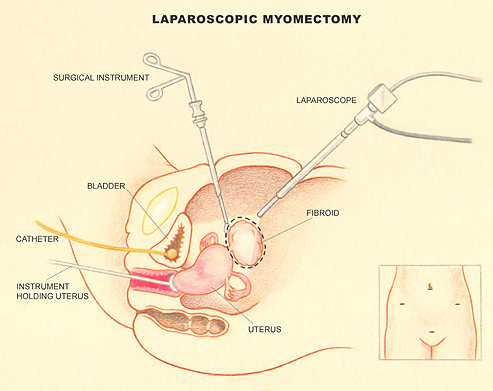What is Laparoscopic Myomectomy?
Laparoscopic Myomectomy is a minimally invasive surgical procedure to remove uterine fibroids (myomas) while preserving the uterus. Unlike an open myomectomy, this technique uses small incisions and advanced laparoscopic instruments to excise fibroids, offering faster recovery and minimal scarring. It is ideal for women who wish to retain their uterus for future pregnancy or personal reasons.
Laparoscopic myomectomy is an excellent choice for women who wish to manage fibroid-related symptoms while preserving fertility and minimizing recovery time. Consult your gynecologist to evaluate your fibroid size, location, and suitability for laparoscopic removal to achieve optimal outcomes.

Symptoms Indicating the Need for Laparoscopic Myomectomy
Women with uterine fibroids may experience:
- Heavy menstrual bleeding (menorrhagia)
- Pelvic pain or pressure
- Frequent urination
- Difficulty emptying the bladder
- Constipation
- Pain during intercourse
- Infertility or recurrent pregnancy loss
If these symptoms affect your daily life or fertility, a laparoscopic myomectomy may be recommended.
Procedure or Treatment: How is Laparoscopic Myomectomy Done?
- Anaesthesia: Performed under general anaesthesia.
- Incisions: The surgeon makes small keyhole incisions in the abdomen.
- Laparoscope Insertion: A laparoscope (tiny camera) is inserted to visualize the uterus.
- Fibroid Removal: Surgical instruments are used to cut and remove fibroids precisely.
- Uterine Repair: The uterus is reconstructed with sutures to ensure proper healing.
- Closure: Instruments are removed, and incisions are closed with minimal suturing or skin glue.
The procedure usually takes 1-3 hours, depending on the size, number, and location of fibroids.
Prevention
Currently, there is no definitive prevention for uterine fibroids, but certain lifestyle habits may reduce risk:
- Maintaining a healthy weight
- Eating a balanced diet rich in green vegetables and low in red meat
- Managing stress effectively
- Regular physical activity
- Routine gynecological check-ups for early detection
Benefits of Laparoscopic Myomectomy
- Minimally invasive with small scars
- Faster recovery compared to open surgery
- Less postoperative pain
- Shorter hospital stay (usually 1-2 days)
- Preservation of the uterus for future pregnancy
- Reduced risk of adhesions
- Enhanced cosmetic results
Types of Myomectomy Procedures
- Laparoscopic Myomectomy: Minimally invasive removal of fibroids via laparoscopy.
- Hysteroscopic Myomectomy: Removal of fibroids within the uterine cavity using hysteroscopic techniques, with no external incisions.
- Abdominal (Open) Myomectomy: Traditional open surgery for very large or multiple fibroids not amenable to laparoscopy.
- Robotic Myomectomy: An advanced version of laparoscopic myomectomy using robotic assistance for greater precision.
